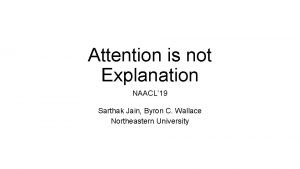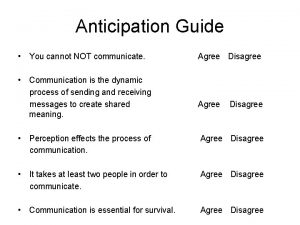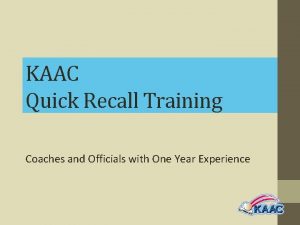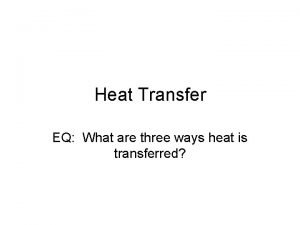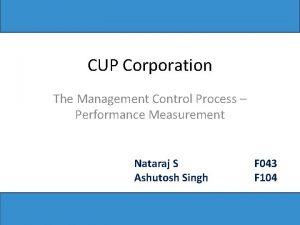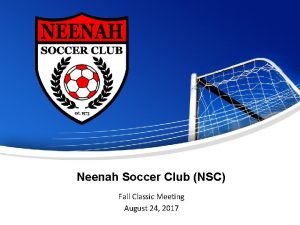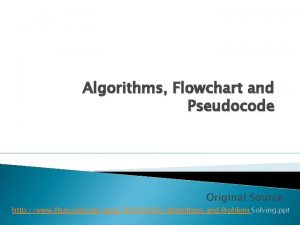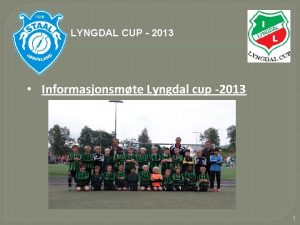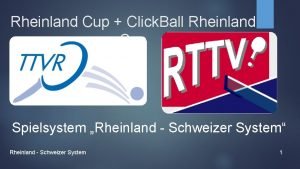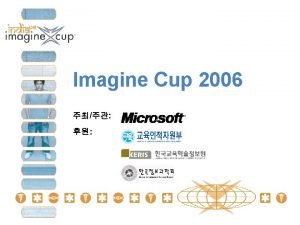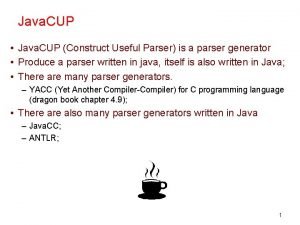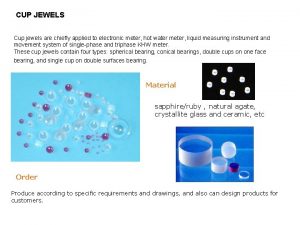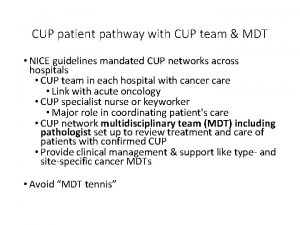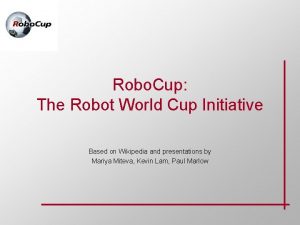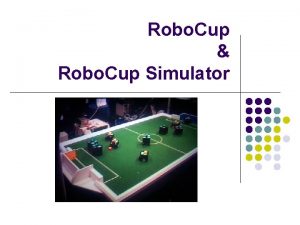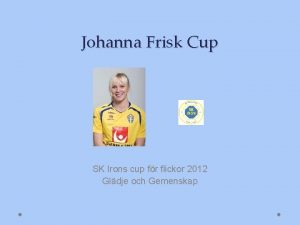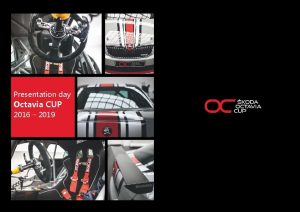To CUP or Not To CUP That is










































- Slides: 42

To CUP, or Not To CUP? That is the (FICON) Question! Ohio Valley CMG Sept 20, 2007 Steve Guendert, Ph. D (cand) Principal Engineer Brocade Communications

Abstract CUP, or Control Unit Port is a holdover from ESCON directors. In a FICON environment, CUP allows for in-band management, and opens the door to FICON director performance metrics via the RMF 74 -7 record, more commonly known as the FICON Director Activity Report. In an effort to reduce acquisition costs and be more competitive on price, many vendors will try and make the case why you do not need CUP on FICON directors. This paper will present the reasons why, from a performance management perspective, "that not to CUP" is the wrong answer to the question posed by the paper title. Sept 2007 To CUP or Not To CUP? © 2007 Brocade Communications Systems, Inc. All rights reserved. 2

Agenda What is CUP? History of CUP ESCON use FICON Director Activity Report (RMF 74 -7) Sept 2007 To CUP or Not To CUP? © 2007 Brocade Communications Systems, Inc. All rights reserved. 4

Control Unit Port – CUP on FICON is a legacy of CUP on ESCON The 9032 -5 ESCON Directors have an in-band management capability that utilized an embedded port in the control processing cards to provide a communications path to an MVS console – It was used to report hardware errors up to MVS (Helpdesk) – It was used to block and unblock ports (PDCMs) – It was used to monitor performance When switched-FICON was being engineered, IBM wanted to be sure that its users would have a consistent look and feel between ESCON and FICON including CUP Take note - the mainframe sets the clock to GMT through CUP – This is not really desirable for open systems people if you have an intermix environment Sept 2007 To CUP or Not To CUP? © 2007 Brocade Communications Systems, Inc. All rights reserved. 5

FICON CUP Support CUP = Control Unit Port (an embedded not physical port) – Allows in-band management of Directors from the management applications on a Mainframe • Used for configuration, monitoring, and error handling CUP support is provided by all vendors – Usually it is an optional licensed feature – Supported in single or cascaded FICON environments CUP is typically used by customers with: – SA/z. OS (System Automation software) configuration tool – RMF (Resource Measurement Facility) monitoring tool • • Sept 2007 There a lot of things going on in a FICON storage network Some very important information is gathered by RMF from CUP To CUP or Not To CUP? © 2007 Brocade Communications Systems, Inc. All rights reserved. 6

Details of CUP Control Unit Port There are 39 CUP commands, or Channel Command Words (CCWs), for monitor and control of switch functions Due to the historic nature and use of ESCON CUP, FICON CUP commands are oriented toward management of a single switch Although the use of CUP in a cascaded environment is supported, CUP is primarily limited to controlling a single switch at a time Sept 2007 To CUP or Not To CUP? © 2007 Brocade Communications Systems, Inc. All rights reserved. 7

CUP Under ESCON ESCD Inband CHPIDs System Automation OS 390 Application Called ‘ESCON Manager’ FE Embedded Port ESCON manager Embedded port FE is also called the ‘Control Unit Port’ or CUP MVS Consoles or ESCON workstation can control the ESCON Director Best practice was to have 2 or more CHPIDs with access to the CUP Safe switching Sept 2007 To CUP or Not To CUP? © 2007 Brocade Communications Systems, Inc. All rights reserved. 8

Initial Program Load (IPL) The IPL is a special configuration file identified by the unique file name “IPL” The parameters contained in the IPL file are the same as other configuration files, but there are special uses for this file The configuration defined by the IPL will be applied upon reboot of the FICON Director/switch – This could be a scheduled downtime reboot – Or this could be an unscheduled power failure for example Active=Saved Setting (a Mode Register bit - discussed later): – When the Active=Saved Mode is enabled, changes made to the active configuration (HCD settings) are also stored in the IPL – When Active=Saved Mode is disabled, at reboot the HCD settings will be restored to the FICON switching device which might not accurately reflect the hardware state of the box • Sept 2007 Especially if port swaps have not been updated in the HCD To CUP or Not To CUP? © 2007 Brocade Communications Systems, Inc. All rights reserved. 9

Using CUP Configuration of the FICON Director Port Connectivity Attributes – Prohibit/Allow: “Prohibit Dynamic Connectivity Mask” or PDCM • • Prohibits (blocks) or Allows connectivity between ports Basically, it is simple single switch zoning for FICON – Done at the hardware level – blocking physically blocks a port from receiving frames regardless of zoning and preferred path, etc. Port Address Name Switch Name Set system time on the switch Set the switch offline Sept 2007 To CUP or Not To CUP? © 2007 Brocade Communications Systems, Inc. All rights reserved. 10

CUP Logical Path Establishment and CCW Flow Mainframe (Channel) FICON Director Control Unit PLOGI to port “FE” PLOGI Accept Establish Logical Path (ELP) Logical Path Established (LPE) Link Level Ack (LACK) CCW 1 CCW 2 CCW 3 Status Sept 2007 To CUP or Not To CUP? © 2007 Brocade Communications Systems, Inc. All rights reserved. 11

Using CUP In-band Monitoring of the FICON Director Port Statistics – Number of words transmitted, received, etc – These counters are already available in the switch Switch Node Identifier – Serial Number, Manufacturer, etc – The information is the same Switch Node ID provided in the RNID ELS Configuration File Information – List of Configuration files residing on the switch – Actual file content, including port address name and port connectivity History Summary (Directory History Buffer) – Each change in status or configuration of the ports is logged in a history buffer – The history buffer can be retrieved through CUP Switch Configuration Data – Timeout values, number ports per card, etc Sept 2007 To CUP or Not To CUP? © 2007 Brocade Communications Systems, Inc. All rights reserved. 12

PDCMs Prohibit Dynamic Connectivity Mask and Zoning The Prohibit Dynamic Connectivity Mask (PDCM) is a mechanism to define port connectivity (also referred to as prohibit/allow and blocking and unblocking) Prohibiting ports using PDCM across zones is redundant – Zoning rules already prohibit the devices from communicating – In the event of a conflict between zoning and PDCM definitions, the most restrictive rules are automatically applied E-Ports and PDCM Sept 2007 To CUP or Not To CUP? © 2007 Brocade Communications Systems, Inc. All rights reserved. 13

Additional Benefit - Port Swapping Move FICON Cables without IOCP Update Swaps port assignments for a pair of switch ports Slot 1 Enables FICON storage devices to be moved onto different ports without the need to update the mainframe I/O configuration file (via HCD usually) Supports Mainframe z. OS use of static I/O definitions Users can swap ports across all ports within a switch or Director NOTE: If the optical transceiver has failed, and not the port, just swap out the optics and re-cable back into the original port – A port swap would not be necessary! Defective port is address-swapped to a good port Sept 2007 To CUP or Not To CUP? © 2007 Brocade Communications Systems, Inc. All rights reserved. 14

FICON Configure Allow/Prohibit Matrix PDCMs ISL Port Notice the tool tip is showing that the mouse is over the cell that intersects 0 C and 08. Using the PDCM matrix, we can physically block the connection of Fport(s) to E-port(s) Physically cannot send a frame to that E-port Sept 2007 To CUP or Not To CUP? These F-ports cannot be allocated to this E-port © 2007 Brocade Communications Systems, Inc. All rights reserved. 15

EFC Manager for FICON Management “Port Swap“ Sept 2007 To CUP or Not To CUP? © 2007 Brocade Communications Systems, Inc. All rights reserved. 16

FICON Management - Port Swap Port address swapping Sept 2007 To CUP or Not To CUP? © 2007 Brocade Communications Systems, Inc. All rights reserved. 17

Reasons That CUP Is Very Useful If the user wants to be able to do in-band management from their Hardware management consoles, they need CUP – If they want to be able to use the management tools they are familiar with from ESCON, be it ESCON manager, System Automation OS/390 I/O-Ops, etc. If it is important to them to get the Service Information Messages (SIM) to the MVS console for FICON device hardware failures If the user plans on using the Dynamic CHPID Manager function of Workload Manager (DCM) when it becomes available for FICON If they want to do RMF Monitor I reports for reporting on FICON Director activity statistics in the SMF Record Type 74 Subtype 7, they need CUP – – Sept 2007 RMF Monitor I does long term data collection for resource utilization I’ll cover RMF in more detail in a few slides To CUP or Not To CUP? © 2007 Brocade Communications Systems, Inc. All rights reserved. 18

Differences in CUP from ESCON to FICON ESCON did not use buffer credits – ESCON was half-duplex so an acknowledgement had to be received after each and every frame was sent FICON does use buffer credits – FICON is full-duplex, buffer credits provide flow control RMF needs to report on these fancy, new “Buffer Credits” – IBM chose to do this by creating RMF 74 subtype 7 records – RMF 74 subtype 7 records are new with FICON – RMF 74 subtype 7 records are only provided via FICON CUP – RMF 74 subtype 7 records are needed to understand FICON performance – RMF 74 subtype 7 records create a “FICON Director Activity Report” during each reporting interval for each CUP found Sept 2007 To CUP or Not To CUP? © 2007 Brocade Communications Systems, Inc. All rights reserved. 19

CUP Under FICON CHPIDs Switches/Directors have an embedded port “FE” in the control processor On 256 port Directors, this logical “FE” overlaps the physical port “FE” Using CUP, on 256 port boxes, physical ports “FE” and “FF” cannot be used In that case, use “FE” and “FF” for port swapping and for intermix ports Only one RMF should attempt to access “CUP” at any one time Too much activity to “CUP” can cause missing interrupts – boxed device Best practice is still to have 2 or more CHPIDs with access to the CUP Sept 2007 To CUP or Not To CUP? © 2007 Brocade Communications Systems, Inc. All rights reserved. 20

CUP Under FICON CHPIDs Wanted EXACTLY the same kind of capability for CUP under FICON Wanted z/OS consoles to be able to configure and manage FICON An embedded port – FE – in the FICON Director provides this support Once again, embedded port FE is called the ‘Control Unit Port’ or CUP MVS Console or EFCM server can then control the FICON Director Best practice is still to have 2 or more CHPIDs with access to the CUP Sept 2007 To CUP or Not To CUP? © 2007 Brocade Communications Systems, Inc. All rights reserved. 21

CUP for Use With RMF Much has changed in FICON – Multiple ESCON links can be aggregated onto a single FICON link – FICON allows full-duplex operations rather than the unidirectional technology of ESCON – FICON allows Fan In and Fan Out to really be effective (ESCON did not) – ESCON did not have a function like FICON Cascading – And lets not forget that all of these could be out of tune at the same time! Sept 2007 To CUP or Not To CUP? © 2007 Brocade Communications Systems, Inc. All rights reserved. 22

CUP for Use With RMF In MY opinion, RMF is the KEY motivator for using CUP: – RMF is a mainframe-centric view of the channel and device activity – Without CUP, RMF has no idea how fabric connectivity is affecting the I/O activity that it sees on any given CHPID – With CUP, an RMF FICON switch shares the gathered statistics about each of its ports enabling RMF to accurately report I/O channel and device activity as well as network timings CUP is turned on by implementing FICON Management Server (FMS) – A Fee-based software key that must be configured on each and every FICON switch for which CUP will be enabled What has changed that makes CUP more important in FICON? Sept 2007 To CUP or Not To CUP? © 2007 Brocade Communications Systems, Inc. All rights reserved. 23

CUP for Use With RMF ØFor RMF reporting, constructs such as Unit Control Block (UCB) and Logical Control Unit (LCU) are used to store gathered statistics (RMF Monitor I) ØA UCB is a device that is accepting or creating frame traffic ØA LCU is a control unit definition that encompasses one or more UCBs at a higher level ØRMF assumes he owns and controls everything in the universe (what SAN? ) ØCan only measure and report on what is told to him about devices and paths ØDoes not really understand anything about channel aggregation, fan in-fan out, and ISLs ØMost z/OS customers live and die by their RMF performance tuning! Sept 2007 To CUP or Not To CUP? © 2007 Brocade Communications Systems, Inc. All rights reserved. 24

Networked FICON Has Special Issues Cup Code Allows RMF To Report On These Issues! Director attached I/O 1. 4 : 136 4. 1. Cascaded I/O 6. 3. 4 : 272 EFCM rather than RMF might be the best tool to use to solve this problem 2. 5. 1. Could have FICON CHPID oversubscription due to incorrect aggregation 2. Could have Storage Port oversubscription due to incorrect Fan-Out aggregation 3. Could have ISL congestion due to changing workloads or improper Fan. In-Fan. Out aggregation 4. Could have a permanent or intermittent frame pacing delay situation affecting performance 5. Maybe in a FICON and FC intermix structure, the SAN is causing CU busy problems out in storage 6. Maybe FICON and FC are using the same DASD and Open Systems is causing CU busy problems Sept 2007 To CUP or Not To CUP? © 2007 Brocade Communications Systems, Inc. All rights reserved. 25

CUP for Use With RMF Just have the correct record subtypes turned on so the Director port I/O data can be reported in RMF. (RMF 74 subtype 7) Sept 2007 To CUP or Not To CUP? © 2007 Brocade Communications Systems, Inc. All rights reserved. 26

CUP for Use With RMF Just have the correct record subtypes turned on so the Director port I/O data can be reported in RMF. (RMF 74 subtype 7) one LPAR’s path, RMF communicates with each FICON • From one, and only switch in turn, requesting that its “FE” port dump all FICON port statistics down to the mainframe. • Then RMF distributes that information to all the other LPARs on the mainframe • A FICON Switching Device report is generated for each FICON device with Also, timeout values need to be changed from 30 seconds to 3 minutes on the Missing CUP Interrupt Handler (MIH) on older EOS’s Sept 2007 To CUP or Not To CUP? © 2007 Brocade Communications Systems, Inc. All rights reserved. 27

CUP and FICON Management Server Unit check status – MVS Console/Service Director Help Desk Functions Port Statistics – Remote Measurement Facility Node Descriptors – Work Load Manager • Dynamic Channel Path Management (DCM) - future – System Operations (Safe Switching) Allow/Prohibit Configuration – Block/Unblock port to port connectivity • Including Inter-switch Links (ISLs) – Supports System Automation OS/390 on the mainframe Switch Configuration – Configure and monitor I/O Operations – Control via EFCM or System Automation OS/390 Sept 2007 To CUP or Not To CUP? © 2007 Brocade Communications Systems, Inc. All rights reserved. 28

Generating a CUP Device Address 07 17 The CUP address is always FE and a specific CUP address notation in a fabric is dd-FE-xx where dd is the domain ID of the switch, FE is the embedded port address and xx we do not care about currently CHPID PATH=(07, 17), SHARED, TYPE=FC, SWITCH=7 A CNTLUNIT CUNUMBR=F 008, PATH=(07, 17), UNIT=2032, UNITADD=((00, 1)), LINK=(7 AFE, 7 AFE) IODEVICE ADDRESS=(F 008, 1), UNITADD=00, CUNUMBER=(F 008), UNIT=2032 Sept 2007 To CUP or Not To CUP? © 2007 Brocade Communications Systems, Inc. All rights reserved. e! he YS t A W AL 29 typ unit

Generating a CUP Device Address 07 17 The CUP address is always FE and a specific CUP address notation in a fabric is dd -FE-xx where dd is the domain ID of the switch, FE is the embedded port address and xx we do not care about currently e! typ unit CHPID PATH=(07, 17), SHARED, TYPE=FC, SWITCH=7 A e S th Y A CNTLUNIT CUNUMBR=F 008, PATH=(07, 17), UNIT=2032, ALW UNITADD=((00, 1)), LINK=(7 AFE, 7 AFE) IODEVICE ADDRESS=(F 008, 1), UNITADD=00, CUNUMBER=(F 008), UNIT=2032 With multiple switches in a fabric with CUP, define them all in the same way, but the LINK statement will have the different domain IDs of the different switches: i. e. LINK=(61 FE) or LINK=(6 EFE) or LINK=(74 FE) etc. Sept 2007 To CUP or Not To CUP? © 2007 Brocade Communications Systems, Inc. All rights reserved. 30

Using CUP DID 7 A Genning CUP CHPID PATH=(07, 17), SHARED, TYPE=FC, SWITCH=7 A CNTLUNIT CUNUMBR=xxxx, PATH=(07, 17), UNIT=2032, UNITADD=((00, 1)), LINK=(7 AFE, 7 AFE) IODEVICE ADDRESS=(xxxx, 1), UNITADD=00, CUNUMBER=(xxxx), UNIT=2032 From one, and only one LPAR path, RMF communicates with each FICON switch (the CTP card) in turn, requesting that its “FE” port dump all FICON port statistics down to the mainframe The “master” RMF then distributes that information to all the other LPARs on the mainframe A FICON Switching Device report is generated for each FICON device with CUP If necessary, timeout values for the Missing Interrupt Handler (MIH) need to be changed from the default 30 seconds to 3 minutes Sept 2007 To CUP or Not To CUP? © 2007 Brocade Communications Systems, Inc. All rights reserved. 31

FICON Director Measurements F-port to ISL Interconnection Frame Pacing Delay R/W MBps Error Count For ISLs and F-ports RMF’s FICON Switching Device Report Components Host-to-Director FICON Director-to-Storag FICON 2 / 1 aggregation 5 / 2 aggregation 9 Channels FAN-IN 2 / 4 / 10 Gbps ISL’s 4 Channels FAN-OUT RMF 74 subtype 7 records turned on and CUP code implemented! Sept 2007 To CUP or Not To CUP? © 2007 Brocade Communications Systems, Inc. All rights reserved. 32

Frame Pacing Delay AVG FRAME PACING – Defined by RMF as the average number of time intervals of 2. 5 microseconds that a frame has to wait before it could be transmitted due to no buffer credits being available. You always want to see a zero value in this field! – Reporting on this value was one of the primary reason that the RMF 74 -7 record was developed – it was not needed for ESCON – A non-zero value in the AVG FRAME PACING field indicates that you have an issue with insufficient BB Credits – It is critical to use CUP in any FICON environment in which distance extension is being utilized – 4 Gbps may create more Frame Pacing Delay issues than 2 Gbps z/OS disk workloads rarely use a "full" 2148 byte credit – For example, with a 4 k block transfer, the average frame size for each 4 k transfer is typically about 819 bytes Sept 2007 To CUP or Not To CUP? © 2007 Brocade Communications Systems, Inc. All rights reserved. 33

Frame Pacing versus Frame Latency Frame Pacing is an FC 4 application data exchange level measurement and/or throttling mechanism – Pacing is determined by the channel based upon feedback from the control unit – It is managed between the server and storage or channel and control unit – It is gauged by the performance characteristics of the data exchanges and resource availability and can be modified by the channel on the fly Frame Latency is a frame delivery level measurement – The mount of time it takes a frame to be delivered and it depends upon how it is measured • Most measurements are the amount of time it takes a frame to travel from the server to the storage (channel to control unit) • Each element that handles the frame contributes to this latency measurement (HBA, switch, storage HBA) • Our measurement is the average amount of time it takes us to deliver a frame to the destination port (i. e. from the moment the SOF enters the source port to the moment the EOF leaves the destination port) Why do we care about these measurements? – They help determine which parts of the system diminish the ability to send frames at theoretical speed of light in fibre – One way to look at latency is it's like measuring frame "friction" Sept 2007 To CUP or Not To CUP? © 2007 Brocade Communications Systems, Inc. All rights reserved. 34

FICON Director Activity Report Sept 2007 To CUP or Not To CUP? © 2007 Brocade Communications Systems, Inc. All rights reserved. 35

Frame Pacing Delay Being Reported Sept 2007 To CUP or Not To CUP? © 2007 Brocade Communications Systems, Inc. All rights reserved. 36

Local Frame Pacing Delay How can you run out of buffer credits inside a datacenter? – Frame pacing delays occur when multiple, heavily used paths merge into a single FICON link – Frame pacing delays can contribute to PEND, DISC, and CONN time measurements es m ra s F 0 10 Frames 300 MBps Bp M Frames 100 MBps Fr am es 10 0 Now this CONGESTED cascaded link is causing MBps additional PEND and/or CONN time to many storage ports and possibly additional IOS Queue Time to some of the CHPIDs Sept 2007 To CUP or Not To CUP? Frame Pacing Delay is caused by running out of buffer credits! UCBs serviced by these storage ports are probably experiencing additional delays usually reported as PEND Time and CONN Time and sometimes as DISC time Frame Pacing Delay came about with FC and FICON so it is not a factor in ESCON performance! © 2007 Brocade Communications Systems, Inc. All rights reserved. 37

Long Distance Frame Pacing Delay An example using a 20 km distance Frame Pacing Delay on M 6140 Sept 2007 To CUP or Not To CUP? Frame Pacing Delay on 48000 © 2007 Brocade Communications Systems, Inc. All rights reserved. 38

Access CUP via Low Utilized CHPIDs 1 EXAMPLE 2 z. Series 3 4 6 1 FC FC FC 6 CHPIDs 8 2 CHPIDs To CUP C 11 FICON Switch FE 30 35 3 A z. Series 3 4 2 CHPIDs To CUP C FICON Switch FE 28 CUP FE 35 Devices To CUP or Not To CUP? 2 ISLs 28 30 4 CHPIDs To DASD CU FAN-IN 16 CUP 20 CU 6 1 A 20 Same 2 CHPIDs To CUP 11 4 3 F Storage Array CU CU 5 FC FC FC 8 1 A CUP 2 6 CHPIDs 16 4 The CUP is going to put a data load onto the path between the switch and the mainframe. Choose CHPIDs that are more lightly utilized to handle this systems created workload 4 so that performance CHPIDs is not affected by the. CU To DASD CUP. Sept 2007 5 3 A 3 F Storage Array CU CU Could be the same or a different set of CHPIDs to access th remote CUP FAN-OUT CU Devices © 2007 Brocade Communications Systems, Inc. All rights reserved. 39

Things most often left out of proposals Dual Cabinets to provide a five-9’s, non co-located high availability environment FICON Management Server to provide CUP services on FICON switching devices Dual cabinets and FMS are the most important of the features that are often removed from proposals Sept 2007 To CUP or Not To CUP? © 2007 Brocade Communications Systems, Inc. All rights reserved. 40

Conclusions and observations Use of CUP in a FICON environment is the only way to gain the benefits of RMF reporting on FICON Directors. CUP and RMF together provide crucial performance management information, particularly for cascaded FICON architectures. IBM has been talking for years about moving away from CUP. Their intent is to move the functionality that is only available from the CUP into other applications sometime in the future. With that said, there may be new features that IBM wants to roll out and they may be making some progress on this plan. We will not know until IBM finally makes an announcement at some time in the future – until then – Enjoy CUP! Sept 2007 To CUP or Not To CUP? © 2007 Brocade Communications Systems, Inc. All rights reserved. 41

Questions? ? Sept 2007 To CUP or Not To CUP? © 2007 Brocade Communications Systems, Inc. All rights reserved. 42

THANK YOU
 Tìm độ lớn thật của tam giác abc
Tìm độ lớn thật của tam giác abc Sau thất bại ở hồ điển triệt
Sau thất bại ở hồ điển triệt Thơ thất ngôn tứ tuyệt đường luật
Thơ thất ngôn tứ tuyệt đường luật Hãy nói thật ít để làm được nhiều
Hãy nói thật ít để làm được nhiều Thơ thất ngôn tứ tuyệt đường luật
Thơ thất ngôn tứ tuyệt đường luật Tôn thất thuyết là ai
Tôn thất thuyết là ai Phân độ lown
Phân độ lown Walmart thất bại ở nhật
Walmart thất bại ở nhật Gây tê cơ vuông thắt lưng
Gây tê cơ vuông thắt lưng Block xoang nhĩ độ 2
Block xoang nhĩ độ 2 Vocab level d unit 3
Vocab level d unit 3 Casual vs formal
Casual vs formal Love is not all rhyme scheme
Love is not all rhyme scheme We will not be moved when everything around is shaking
We will not be moved when everything around is shaking Attention is not not explanation
Attention is not not explanation Ears that hear and eyes that see
Ears that hear and eyes that see Not a rustling leaf, not a bird in flight
Not a rustling leaf, not a bird in flight If p, then q
If p, then q Being too broad
Being too broad P ran
P ran If you're not confused you're not paying attention
If you're not confused you're not paying attention You cannot not communicate
You cannot not communicate Small just
Small just Quotes on measurement
Quotes on measurement Wolrd cup 2006
Wolrd cup 2006 Coffee cup calorimeter equation
Coffee cup calorimeter equation Quick recall questions
Quick recall questions United 2026 world cup
United 2026 world cup Cup
Cup Cup and cone fracture
Cup and cone fracture Thermochemistry notes
Thermochemistry notes Design on cup
Design on cup A spoon in a cup of hot soup becomes warmer
A spoon in a cup of hot soup becomes warmer Vessyl cup
Vessyl cup Stove uses and functions
Stove uses and functions What is the main objectives of salad?
What is the main objectives of salad? Hindu creation story
Hindu creation story World scholar's cup collaborative writing examples
World scholar's cup collaborative writing examples Cup corporation
Cup corporation Tilt a cup minute to win it
Tilt a cup minute to win it Progeek
Progeek Nsc fall cup
Nsc fall cup Flowchart examples
Flowchart examples














